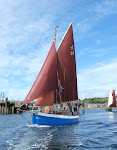
All the caulking and stopping is now complete, including under the cradle pads.
I asked Paul to fit the copper top on the rudder, and that is done too. Paul is going to leave the trestles and plank that he uses for easier access to the top sides so I can use them for painting, but we won't see him again until he comes to collect them. The rest of the work is down to us!
Alex and I have been going to Robinetta a fair bit, even Julian went one day! (Although he's done so much at home that saying it that way is unfair). Between us we spent another 11 days at West Mersea since my last post, resulting in the following:

The mast has had 2 coats of varnish, as has the boom, while the rudder top has had one.
The new mast collar is in place

The belaying pin rack on the foredeck had been stripped of its sadolin and varnolled
The electric pump Julian fitted in a hurry at the end of last season has been properly connected
 The heads thru-hull which seized up last season has been taken home and cleaned (although not yet refitted)
The heads thru-hull which seized up last season has been taken home and cleaned (although not yet refitted)The top sides have been sanded and had a coat of primer on top of the stopping.
I asked the yard about launching, and the earliest they can do it is the end of April, so she's booked to go in then. That leaves four weeks to complete the work and get the mast back in, which should be fine, given half decent weather. Of course I don't want it too warm, or she'll just dry out....







